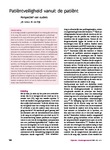Patiëntveiligheid vanuit de patiënt
| dc.contributor.author | Latour, Jos M | |
| dc.contributor.author | van Dijk, M | |
| dc.date.accessioned | 2018-02-27T10:13:43Z | |
| dc.date.available | 2018-02-27T10:13:43Z | |
| dc.date.issued | 2014-10 | |
| dc.identifier.issn | 0376-7442 | |
| dc.identifier.issn | 1875-6840 | |
| dc.identifier.uri | http://hdl.handle.net/10026.1/10874 | |
| dc.description.abstract |
Patient safety has become a focus of interest in today’s health care. Notably in the fields of pediatrics and pediatric surgery, health professionals have been concerned about safety of both children and the parents for quite some time already. Parents are increasingly given a say in quality and safety policy issues. It is not surprising, therefore, that collaboration between parents and professionals is considered an important component of patient safety policy. At the same time, increasing attention is paid to family-centered care, which incorporates the principles of parent participation. However, health professionals are challenged to give room to parents and to provide the means to give them greater involvement in the child’s care. For this to be achieved, open communication and creating a relationship of trust in which parents feel free to communicate their preferences and needs seem to be essential conditions. Measuring experiences of satisfaction of parents through questionnaires is a new trend that allows parents to anonymously provide feedback to the health professionals. The professionals, in turn, can benefit from this feedback, and use the information to improve quality of care and safety in a nursing ward. In our rapidly changing society health professionals cannot but accept that the parents’ role is evolving from observer to co-assessor. | |
| dc.format.extent | 184-188 | |
| dc.language | nl | |
| dc.language.iso | en | |
| dc.publisher | Springer Science and Business Media LLC | |
| dc.subject | Pediatric | |
| dc.subject | Health Services | |
| dc.subject | Clinical Research | |
| dc.subject | Patient Safety | |
| dc.subject | 8.1 Organisation and delivery of services | |
| dc.subject | Generic health relevance | |
| dc.title | Patiëntveiligheid vanuit de patiënt | |
| dc.type | journal-article | |
| dc.type | Journal Article | |
| plymouth.issue | 5 | |
| plymouth.volume | 82 | |
| plymouth.publication-status | Published | |
| plymouth.journal | Tijdschrift voor Kindergeneeskunde | |
| dc.identifier.doi | 10.1007/s12456-014-0038-1 | |
| plymouth.organisational-group | /Plymouth | |
| plymouth.organisational-group | /Plymouth/Faculty of Health | |
| plymouth.organisational-group | /Plymouth/Faculty of Health/School of Nursing and Midwifery | |
| plymouth.organisational-group | /Plymouth/REF 2021 Researchers by UoA | |
| plymouth.organisational-group | /Plymouth/REF 2021 Researchers by UoA/UoA03 Allied Health Professions, Dentistry, Nursing and Pharmacy | |
| plymouth.organisational-group | /Plymouth/Research Groups | |
| plymouth.organisational-group | /Plymouth/Research Groups/Institute of Health and Community | |
| plymouth.organisational-group | /Plymouth/Research Groups/Plymouth Institute of Health and Care Research (PIHR) | |
| plymouth.organisational-group | /Plymouth/Users by role | |
| plymouth.organisational-group | /Plymouth/Users by role/Academics | |
| dc.identifier.eissn | 1875-6840 | |
| dc.rights.embargoperiod | Not known | |
| rioxxterms.versionofrecord | 10.1007/s12456-014-0038-1 | |
| rioxxterms.licenseref.uri | http://www.rioxx.net/licenses/all-rights-reserved | |
| rioxxterms.type | Journal Article/Review |


